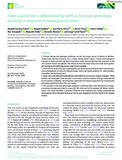Mostrar el registro sencillo del ítem
Holm oak decline is determined by shifts in fine root phenotypic plasticity in response to belowground stress
| dc.creator | Encinas-Valero, Manuel | es_ES |
| dc.creator | Esteban Terradillos, Raquel | es_ES |
| dc.creator | Hereș, Ana-Maria | es_ES |
| dc.creator | Vivas, María | es_ES |
| dc.creator | Fakhet, Dorra | es_ES |
| dc.creator | Aranjuelo Michelena, Iker | es_ES |
| dc.creator | Solla, Alejandro | es_ES |
| dc.creator | Moreno, Gerardo | es_ES |
| dc.creator | Curiel Yuste, Jorge | es_ES |
| dc.date.accessioned | 2022-09-05T08:23:58Z | |
| dc.date.available | 2022-09-05T08:23:58Z | |
| dc.date.issued | 2022 | |
| dc.identifier.citation | Encinas-Valero, M.; Esteban, R.; Here's, A. M.; Vivas, M.; Fakhet, D.; Aranjuelo, I.; Solla, A.; Moreno, G.; Curiel Yuste, J.. (2022). Holm oak decline is determined by shifts in fine root phenotypic plasticity in response to belowground stress. New Phytologist. | en |
| dc.identifier.issn | 0028-646X | |
| dc.identifier.uri | https://hdl.handle.net/2454/43971 | |
| dc.description.abstract | Climate change and pathogen outbreaks are the two major causes of decline in Mediterranean holm oak trees (Quercus ilex L. subsp. ballota (Desf.) Samp.). Crown-level changes in response to these stressful conditions have been widely documented but the responses of the root systems remain unexplored. The effects of environmental stress over roots and its potential role during the declining process need to be evaluated. We aimed to study how key morphological and architectural root parameters and nonstructural carbohydrates of roots are affected along a holm oak health gradient (i.e. within healthy, susceptible and declining trees). Holm oaks with different health statuses had different soil resource-uptake strategies. While healthy and susceptible trees showed a conservative resource-uptake strategy independently of soil nutrient availability, declining trees optimized soil resource acquisition by increasing the phenotypic plasticity of their fine root system. This increase in fine root phenotypic plasticity in declining holm oaks represents an energy-consuming strategy promoted to cope with the stress and at the expense of foliage maintenance. Our study describes a potential feedback loop resulting from strong unprecedented belowground stress that ultimately may lead to poor adaptation and tree death in the Spanish dehesa. | en |
| dc.description.sponsorship | This research was mainly funded by the Spanish Government through the IBERYCA project (CGL2017-84723-P), its associated FPI scholarship BES-2014-067971 (ME-V) and SMARTSOIL (PID2020-113244GB-C21). It was further supported by the BC3 María de Maeztu excellence accreditation (MDM-2017-0714; the Spanish Government) and by the BERC 2018–2021 and the UPV/EHU-GV IT-1018-16 programme (Basque Government). Additionally, this research was further supported through the ‘Juan de la Cierva programme’ (MV; IJCI-2017-34640; the Spanish Government) and one project funded by the Romanian Ministry of Research, Innovation and Digitization through UEFISCDI (A-MH; REASONING, PN-III-P1-1.1-TE-2019-1099). | en |
| dc.format.mimetype | application/pdf | en |
| dc.language.iso | eng | en |
| dc.publisher | Wiley | en |
| dc.relation.ispartof | New Phytologist, 2022 | en |
| dc.rights | © 2022 The Authors. © 2022 New Phytologist Foundation. This is an open access article under the terms of the Creative Commons Attribution-NonCommercial-NoDerivs License http://creativecommons.org/licenses/by-nc-nd/4.0/ | en |
| dc.rights.uri | http://creativecommons.org/licenses/by-nc-nd/4.0/ | en |
| dc.subject | Defoliation | en |
| dc.subject | Holm oak | en |
| dc.subject | Nonstructural carbohydrates | en |
| dc.subject | Phenotypic plasticity | en |
| dc.subject | Root architecture | en |
| dc.subject | Soil nutrient availability | en |
| dc.subject | Trade-off | en |
| dc.title | Holm oak decline is determined by shifts in fine root phenotypic plasticity in response to belowground stress | en |
| dc.type | Artículo / Artikulua | es |
| dc.type | info:eu-repo/semantics/article | en |
| dc.date.updated | 2022-09-05T08:14:25Z | |
| dc.contributor.department | IdAB. Instituto de Agrobiotecnología / Agrobioteknologiako Institutua | es_ES |
| dc.rights.accessRights | Acceso abierto / Sarbide irekia | es |
| dc.rights.accessRights | info:eu-repo/semantics/openAccess | en |
| dc.identifier.doi | 10.1111/nph.18182 | |
| dc.relation.projectID | info:eu-repo/grantAgreement/AEI/Plan Estatal de Investigación Científica y Técnica y de Innovación 2013-2016/CGL2017-84723-P/ES/ | en |
| dc.relation.projectID | info:eu-repo/grantAgreement/AEI/Plan Estatal de Investigación Científica y Técnica y de Innovación 2017-2020/PID2020-113244GB-C21/ES/ | en |
| dc.relation.publisherversion | https://doi.org/10.1111/nph.18182 | |
| dc.type.version | Versión publicada / Argitaratu den bertsioa | es |
| dc.type.version | info:eu-repo/semantics/publishedVersion | en |



